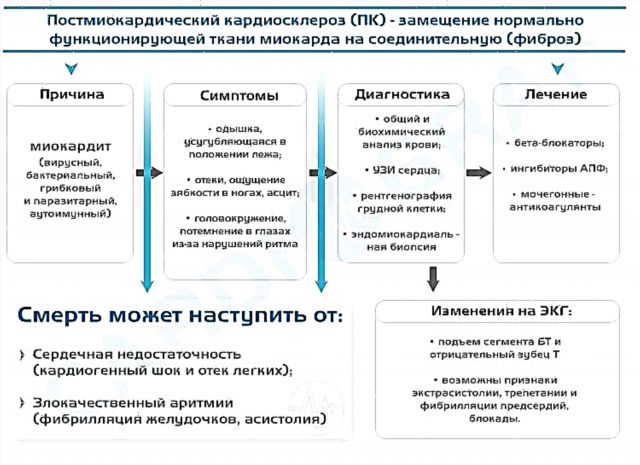Metabolic changes in the myocardium in 60% of patients are an accidental finding during routine ECG. This is due to the often asymptomatic course of the pathology, which cannot even be called an independent disease. Such a metabolic disorder in the heart muscle can be observed with overwork and with various endocrine pathologies. In this article, I will try, as far as possible, to tell you what diagnostic method can be used to recognize this condition.
Process description
Metabolic changes in the myocardium Is a pathological condition accompanied by metabolic disorders:
- proteins,
- carbohydrates
- fat,
- vitamins,
- electrolytes (potassium, calcium, magnesium).
Such changes are not considered a separate disease, but occur against the background of other pathologies.
Impaired nutrition of myocardial cells leads to a decrease in its contractile ability, as well as a loss of electrical automatism. Therefore, the condition is often accompanied by various arrhythmias.
Causes
There are many reasons for metabolic changes in the myocardium. Among them are routine conditions (overwork, stress, the use of energy drinks). In these cases, metabolic disorders in cardiomyocytes do not require urgent medical intervention, since they disappear on their own several hours after the factor is eliminated.
Most often, metabolic disorders are caused by heart disease or non-cardiac pathologies:
- mycardiofibrosis;
- cardiomyopathy provoked by the action of drugs (for example, cardiac glycosides) or toxic substances and allergens;
- myocardial dystrophy;
- amyloidosis of the heart;
- "Gouty" heart;
- alcoholic cardiomyopathy;
- endocrine diseases (thyrotoxicosis);
- general metabolic disorders;
- hypovitaminosis;
- malabsorption, atrophic gastritis, pancreatitis with impaired exocrine activity;
- chronic anemia;
- obesity of any degree;
- strict protein-free diet for weight loss, vegetarianism;
- sluggish infections;
- pathology of renal excretory function;
- hepatitis, liver failure.
Expert advice
Often, hypokalemia (a decrease in the level of potassium in the blood), which leads to a malfunction of the heart muscle, occurs as a result of uncontrolled or improper use of loop diuretics (Lasix, Furosemide). I always draw the attention of my patients to the fact that against the background of this therapy, the excretion of electrolytes from the body increases. Therefore, it is necessary to artificially replenish their volume, in particular by taking "Panangin" or "Caldium".
Symptoms
Signs of metabolic disorders in the myocardium are often absent, therefore, pathology is found by chance, thanks to characteristic changes in the ECG. Sometimes the discomfort from the heart "overshadows" the signs of the underlying disease.
For example, I observed how with an increase in the secretion of thyroid hormones, patients are more worried about tremors in the hands, insomnia, and constant thirst. Therefore, they may simply not pay attention to periodic discomfort behind the sternum.
Among the symptoms of metabolic disorders in the heart muscle, I would note:
- overwork and decreased performance;
- sleep disturbance;
- palpitations, abnormal rhythm;
- shortness of breath;
- recurrent headaches and dizziness;
- pain in the left side of the chest, stabbing or constricting;
- pallor of the skin, cyanosis of the nasolabial triangle;
- short-term loss of consciousness, which may recur periodically.
It is very difficult to call such a clinical picture strictly specific. Similar conditions can occur with many somatic, neurological, infectious diseases, and even with ordinary stress. I strongly advise you not to postpone your doctor's consultation. Early detection is a speedy recovery.
Diagnostic criteria
To identify metabolic changes in the myocardium, it is necessary to exclude hypoxic-ischemic processes in it.
The following signs speak in favor of metabolic disorders:
- clinical picture (pain, arrhythmias);
- muffled heart sounds during auscultation, the appearance of a slight systolic murmur, expansion of the boundaries of the organ during percussion (tapping);
- signs on the ECG (see table below);
- absence of manifestations of ischemia during Holter monitoring and exercise tests;
- a slight increase in the heart, detected by x-ray examination;
- the normal state of the vessels and valves during the Echo-KG against the background of a decrease in the contractile function of the myocardium.
I draw your attention to the fact that the listed criteria should be considered comprehensively.
Characteristic ECG changes
The simplest screening method for diagnosing metabolic disorders in the myocardium is an electrocardiogram. The table shows common metabolic dysfunctions and their signs on the film.
Pathological condition | ECG signs |
Increase in the concentration of calcium in the blood |
|
Decreased levels of calcium in the body |
|
Hypokalemia |
|
Hyperkalemia |
|
Thyrotoxicosis |
|
Chronic alcoholism |
|
Remember that decoding an ECG is not an easy task that requires in-depth physical analysis. This should only be done by a qualified specialist with the appropriate skill.
Clinical case
Patient P., 45 years old, was admitted to the admission department. Delivered by ambulance from the store, where she lost consciousness. Complains of weakness, irritability, trembling hands, palpitations. From the anamnesis: a year ago he was diagnosed with thyrotoxicosis, he does not accept the prescribed therapy. Fainting conditions occur 1-2 times a month, recurrent headache and dizziness, increased blood pressure are also worried. She did not seek medical help. Objectively: the thyroid gland is enlarged, pressure: 150/90 mm Hg, heart rate 100 beats / min, tremors in the fingers, BMI 18, heart sounds are muffled, the boundaries are expanded by 0.5-0.7 mm. Preliminary diagnosis: "Thyrotoxicosis, thyrotoxic myocardial dystrophy".
ECG in dynamics, Echo-KG, stress tests, blood test for TSH and free T4, ultrasound of the thyroid gland, clinical analysis of blood and urine were performed. The diagnosis was confirmed, after which the patient was referred for treatment to an endocrinologist. After a two-week hospital stay, her condition improved.The patient was discharged for outpatient observation at the place of residence.
Which doctors were prescribed for you in case of metabolic changes in the myocardium? Share your experience in the comments.



